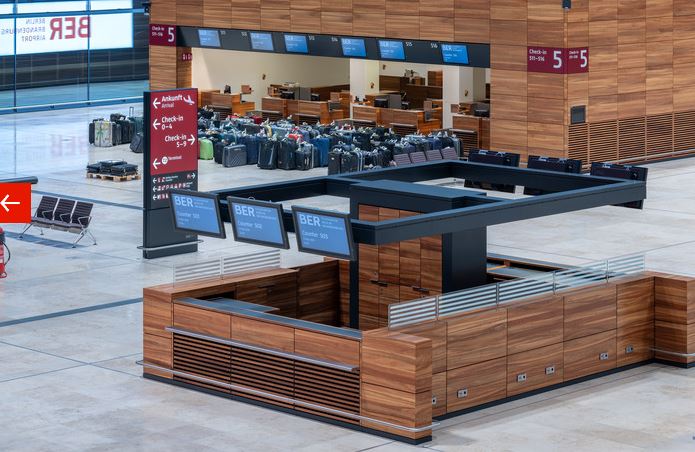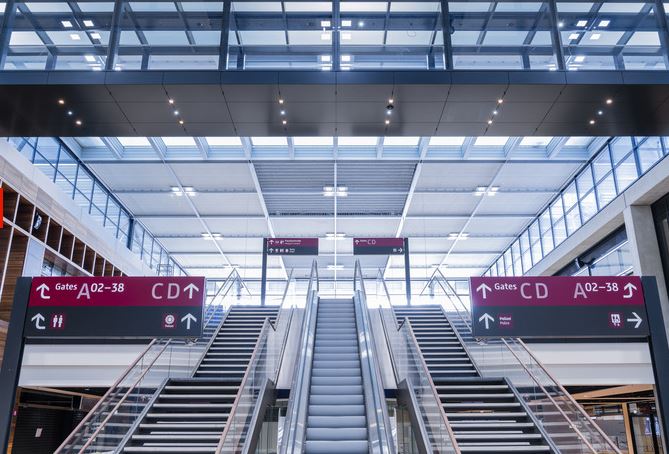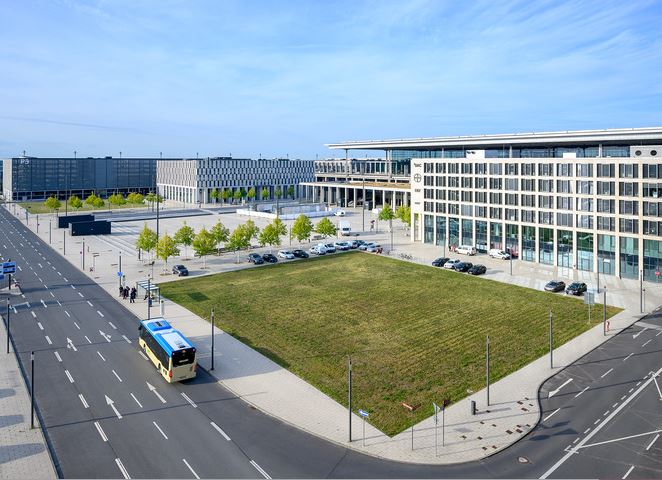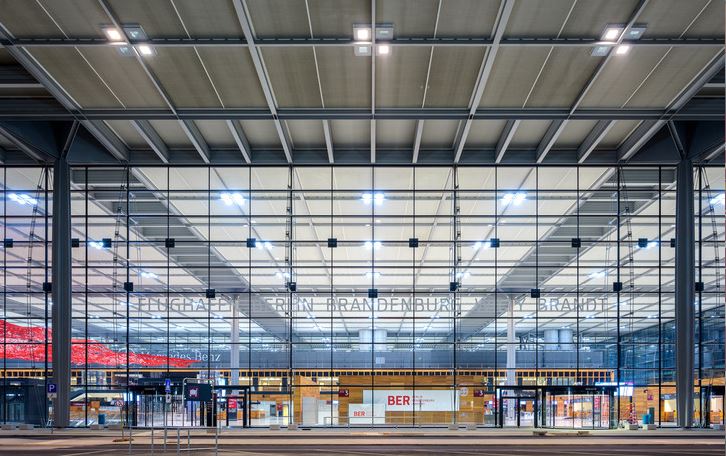
Terminal 1 facade at new Berlin Brandenburg Airport, official opening is October 31st, 2020. (photo Berlin Brandenburg Airport)
By Ron Bernthal
In 2006 the German government announced the commencement of construction of a new airport to replace Berlin-Tegel, a 1948 built airport that was constructed as part of the Berlin airlift following World War II, and then as a military airport before beginning scheduled commercial flights in 1960. Berlin-Tegel was hopelessly overcrowded and outdated, but loved by Berliners because of its convenient location, just five miles (15 minutes taxi drive) from the center of Berlin.
The new airport, named Flughafen Berlin Brandenburg Willy Brandt (English version is Berlin Brandenburg Airport Willy Brandt) was expected to open in 2011. Willy Brandt was both the leader of the Social Democratic Party of Germany (1964-87) and served as Chancellor of the Federal Republic of Germany (West Germany) (1969-74), and was awarded the Nobel Peace Prize in 1971 . He died in 1992 at the age of 79. The new airport is expected to overtake Dusseldorf as Germany’s third busiest, behind Frankfurt and Munich.
Unfortunately, especially for Germany’s reputation for punctuality, serious airport construction and infrastructure delays piled up. Every year since the expected 2011 opening date, the airport’s construction firm had to publicly announce another delay, often due to logistics, or personnel issues, or equipment breakdowns, or financial problems. As the years went by, many German and international air carriers with routes into Berlin had soured about having to change their own operational move-in timetable every year, and the German government continued to spend millons of euro’s just to maintain the site’s structures, security, and environment. Final construction costs are expected to reach 7 billion EUR from the original 3 billion EUR estimate.
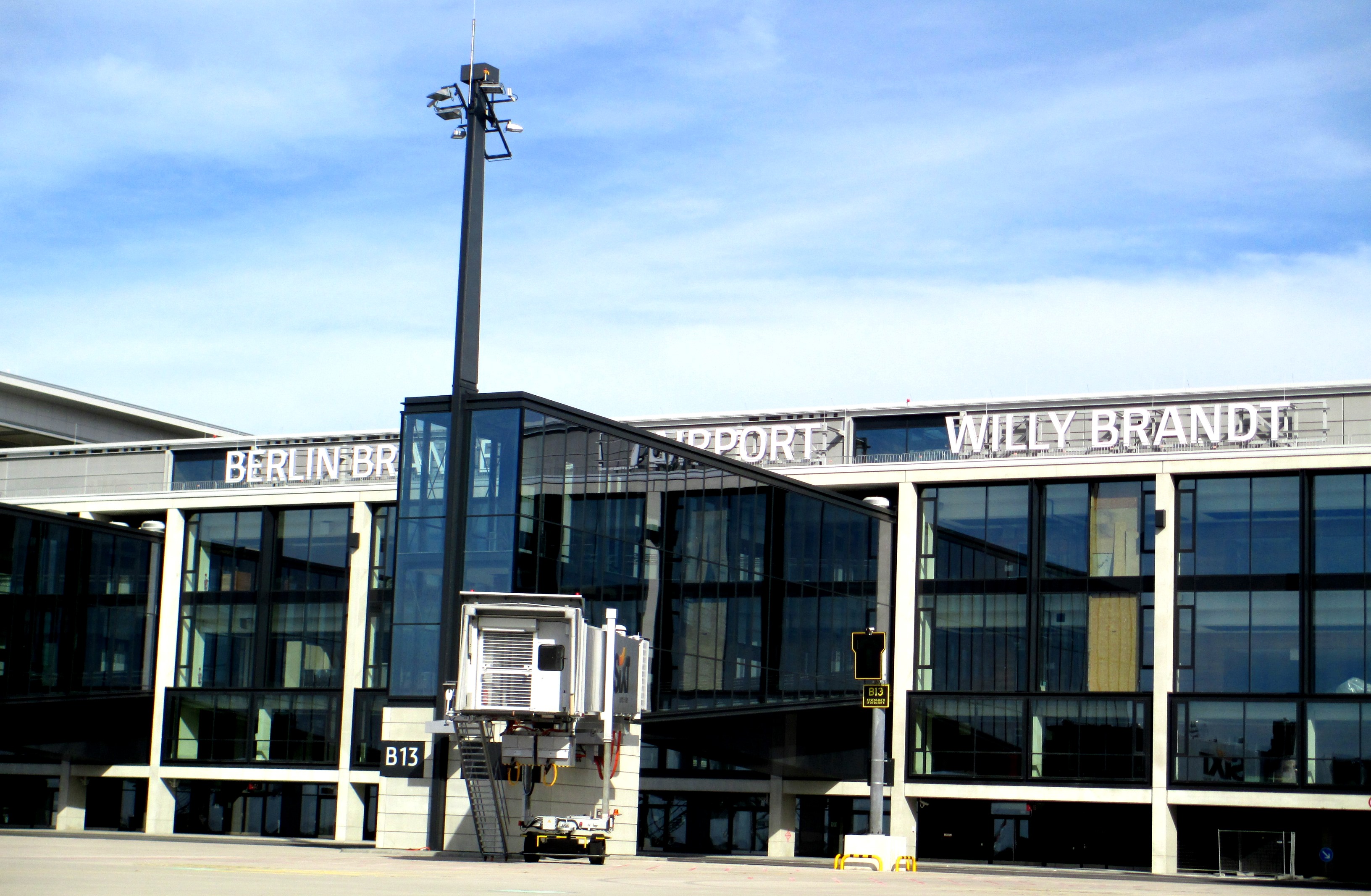
View of Terminal 1 exteerior gate in 2011, almost ready for passengers, but a series of delays would push opening to late 2020. (photo Ron Bernthal)
The airport construction delays caused politicans to lose their posts, businesses to file for bankruptcy, and comedians to flood the airwaves with jokes about Germany’s ongoing construction scandal. If got so bad that Willy Brandt’s descendents requested his name be removed from airport signage and documentation, as they did not want his name to be associated with such a disaster. Apparently, they reconsidered.

Berlin Brandenburg Airport’s runway 07R/25L, 13,123-feet long, awaits the airport’s official opening date in October 2020. (photo Ron Bernthal)
On October 31, 2020, however, all the bad feelings will be mostly forgotten as the new Berlin Brandenburg Willy Brandt Airport (code BER) is, yes, finally scheduled to open, with all the bells and whistles that German technology and creativity can provide.
How do we know it will really open this time? Because on October 1, 2020, the Joint Aviation Authority of Berlin-Brandenburg presented Flughafen Berlin Brandenburg GmbH with permission to begin operations as well as the official airport operating certificate for Berlin Brandenburg Airport Willy Brandt (BER). The completed project is a large, modern, and beautiful facility and, in time, German government officials will forget the expense, trouble and embarrassment that everyone had to go through for more than a decade.
Of course, opening day will not be the first time that aircraft land on BER’s long runways. Because the new facilities were constructed adjacent to Berlin-Schӧnefeld, a small airport that opened in 1934, and used mostly for charter flights, many Berliners were already familiar with driving, or taking the train, from downtown Berlin to Schӧnefeld. After the official opening, the older Berlin-Schӧnefeld will merge its charter flights and other operations into the new Berlin-Brandenburg, and share the BER airport code. With the opening of new terminal T1 (and T2 in early 2021, depending on the increase in passenger and flight operations), the second runway on the southern side of BER will also be inaugurated, and the existing Berlin- Schӧnefeld will terminal will become Terminal 5 (T5), all operated by BER.
With three terminals and two runways on a total area of 3,632 acres, the new BER has an initial annual capacity of 27 million passengers, and the plan is to gradually increase that capacity to an annual 45 million passengers by 2040, creating an estimated 60,000 new jobs by 2035.
With the opening of BER airport, all air traffic in the German capital region will be concentrated in one location. Berlin is a major tourist magnet, political center and trade fair city, and in the past decade the German state of Brandenburg has been gaining economic importance, attracting major global companies, such as Arcelor Mittal, Bombardier, Daimler, Fielmann, Goodyear Dunlop, MTU, Oracle, Rolls-Royce, VW Logistics and Tesla – all with locations in the Berlin/Brandenburg region.
The new BER will become an important hub for linking the strong economic and tourism growth of the region to more than 150 destinations. During the ceremonial opening day, a Lufthansa aircraft and an easyJet plane will be landing simultaneously at the new airport, while dozens of additional airlines will follow with thousands of arrivals and departures.
For airport passengers, BER is connected to the region’s excellent autobahn system and its high-speed ICE and local rail networks, connecting the airport with center city Berlin in 20-50 minutes, After the official opening, up to 14 trains per hour will be available for passengers. Deutsche Bahn (DB) has integrated the BER rail station into its current network and will offer long-distance and local rail connections from the airport station.
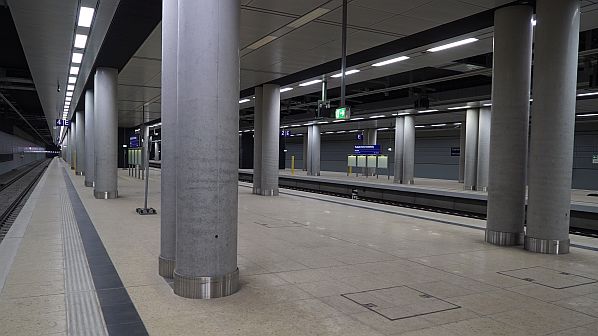
The Berlin Brandenburg Airport’s Deutsche Bahn (DB) rail station will offer Express Trains that connect BER to downtown center city stations in 20 minutes. (photo DB)
“We had already completed our tracks and platform facilities in time for the original scheduled opening date in October, 2011, and we will be ready again when the flights begin in late October, 2020,” said Alexander Kaczmarek, DB’s authorized representative for the State of Berlin.
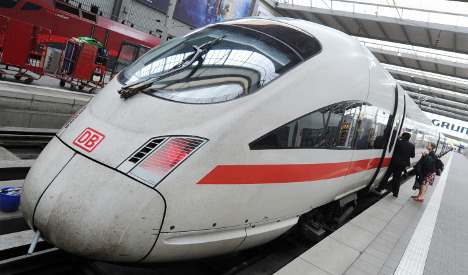
Hi-Speed Deutsche Bahn express trains will connect BER with downtown Berlin in 20 minutes, and with other German and European city rail stations. (photo DB)
Since 2011, DB has had to continuously monitor and maintain the new facilities for safe operation and has been running empty trains to keep the tunnels and station ventilated. Rail times to the center of Berlin are presently 28 minutes for Airport Express services and 51 minutes by S-Bahn. (The Airport Express time will shortly be reduced to 20 minutes when DB completes a project to lay two additional tracks for regional and long-distance trains alongside the existing S-Bahn tracks on the Dresden main line.)
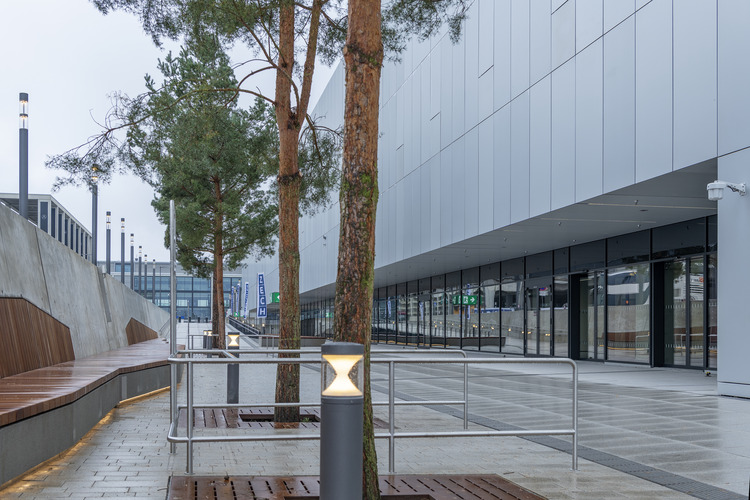
Terminal 2 is a departure and arrival terminal and has an annual capacity of 6 million passengers. It is connected to Terminal 1 via two bridges. Terminal 2 was completed in September 2020. (photo Berlin Brandenburg Airport)
Opening a new airport during a worldwide pandemic will not be easy, but airport management is making passenger safety of paramount importance. As of August 20, 2020, all passengers arriving from high-risk areas into Berlin-Tegel have had to undergo a free COVID test within 72 hours and isolate in a private environment until the results arrive. At the new airport, all passengers will be required to adhere to RKI (Robert-Koch-Institute) guidelines and official government recommendations to contain the virus. These can be found in hygiene protocols and include keeping at least six-feet distance, wearing a mask, and washing / sanitizing their hands regularly. In addition to that, it is recommend that all passengers inform themselves regularly about new safety measures taken by German officials.

The 10,000 square-foot artwork “Magic Carpet” by artist Pae White is among many art pieces throughout Terminal 1. (photo Berlin Brandenburg Airport)
Terminal 1, with its long glass facade, forms the center of the airport complex designed by Meinhard von Gerkan, Hubert Nienhoff and Hans Joachim Paap. The guiding principle for the central terminal was the “one roof concept”, with all the key airport functions bundled together. The new passenger terminal consists of a main, two story hall, spanned by a filigree steel-and-glass roof. Facades feature clear geometrical lines, inspired by architectural concepts from Schinkel to Bauhaus, as well as using materials from local pine forests. The interior is dominated by warm wood tones and natural stone.
The visual centerpiece of the check-in hall is a large, seemingly floating, red wave made of metal mesh flutters. Designed by Los Angeles-based artist Pae White, the work might be reminiscent of a flying carpet or membrane between the known and the unknown.
The airport will eventually feature 39 restaurants and 20 service companies, with an almost 100,000 square-foot retail plaza in the heart of the main terminal.
The Steigenberger Airport Hotel is located adjacent to the terminal, within close walking distance to departure/arrival facilities and the train station. The property is currently taking reservations for stays beginning on October 15, 2020. The hotel offers 322 rooms as well as a conference center with meeting space for up to 500 people, a fine dining restaurant and a spa.
The new airport’s commissioning will begin with the opening of BER’s Terminal 1 on October 31, 2020. On this day, an easyJet aircraft and a Lufthansa aircraft will arrive at the same time and be the first to be received and handled at the new terminal’s Main Pier. On the morning of 4 November, the airport will start operations on the southern runway with a Qatar Airways aircraft landing, while BER’s new night-time flight restrictions will also apply starting on this day. The last flight from Berlin-Tegel will be operated by Air France, from Berlin-Tegel to Paris, on November 8, 2020.

